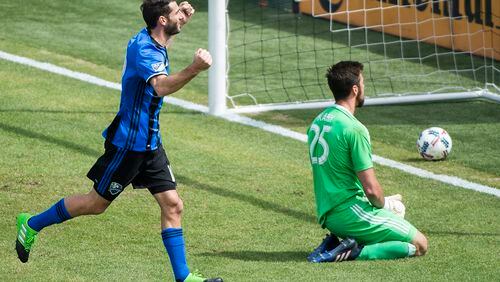One of the more exciting moments in a soccer game can often be the one that involves the least amount of action: the penalty kick.
The penalty kick can cause an entire stadium of people to hold their breath as they begin to mentally work through the variables:
Who will take the kick?
Will he go left, right, or cheekily down the middle?
Will he go low, middle or high?
Will he hit it hard or soft?
Will the goalie guess correctly?
It takes three to five seconds to find out. Either the ball is in the back of the net, or it’s not.
The volume of cheers will tell the story.
Atlanta United finally took its first penalty kick — converted by Miguel Almiron — in last week’s 4-1 win over Houston. The team has had three penalty kicks taken against it through its first 11 regular-season games. The first came against Minnesota United, with Kevin Molino scoring against Atlanta United’s Alec Kann. Molino went to his left. Kann dove to his left. Goal. The second came against Montreal. Ignacio Piatti went to his right, and Kann to his left, but the shot was hit too hard for to be stopped. Goal. The third came against Houston with Erick Torres, after a long run up, going to his right and Kann going to his right. Goal.
“Unfortunately I guessed the wrong way,” Kann said. “It will happen. Sometimes I’ll guess the wrong way, sometimes I’m going to save it.”
There is quite a bit of work that goes into penalties. The first is deciding who will take it. Against Houston, Hector Villalba was the one fouled, resulting in the penalty. But Almiron asked Villalba if he could take it so that he could complete his hat trick.
But there have been instances when teammates have gotten into arguments over who will take the kick. One argument happened in an MLS game last season between the Columbus Crew’s Kei Kamara and Federico Higuain. Both were the designated penalty-takers. Higuain took it and scored. Kamara eventually was traded to New England.
Once it’s decided who will take the shot, then what approach will the player take? Sometimes it is as simple as picking a spot, running up and kicking the ball at that spot with as much force as possible.
On the taker’s side, Miguel Almiron said he works on them in practice. The players can turn into a bundle of nerves, particularly when almost everyone in the stadium is watching.
Sometimes the team will research goalkeepers’ tendencies on penalties, particularly when they know the kicks are a possibility.
Once they get on the field, and are in the moment, players will try different tactics to throw off the goalkeeper. Though it’s against the rules, some players will do the equivalent of a tango as they approach the ball, hoping that the disjointed movements will cause the goalkeeper to move first and leave one side of the net empty for the them to shoot into.
“Once you get up there and know where you want to go you stick with it,” Atlanta United midfielder Jeff Larentowicz said. “Sometimes they save it, and that’s the way it goes. You just have to be confident.”
Larentowicz said he’s never heard of anyone researching their own tendencies when taking penalties. He said it’s easier to guess where the goalie may go than where the taker may go.
Goalies have their own tools.
It starts with research. Kann said the goalkeepers scout the potential takers to see what their tendencies are.
As the kicker places the ball just right and walks back to his starting point, the goalkeeper may try to intimidate him by jumping up and hanging onto the crossbar, pacing back and forth along the line, extending his arms to try to look as big as possible, or by sometimes by walking up and saying something to the taker.
Once everyone is settled, Kann said he tries to read which way the taker may go based upon how he runs to the ball.
If the goalie goes the wrong way, announcers will frequently say that the taker sent the goalie the wrong way with some subtle move. Kann said that’s not the right way to put it.
“It’s an educated guess on our part based upon where they’ve gone in the past and where you’re hoping they will go in the future,” he said. “Penalties are tough for everyone.”







